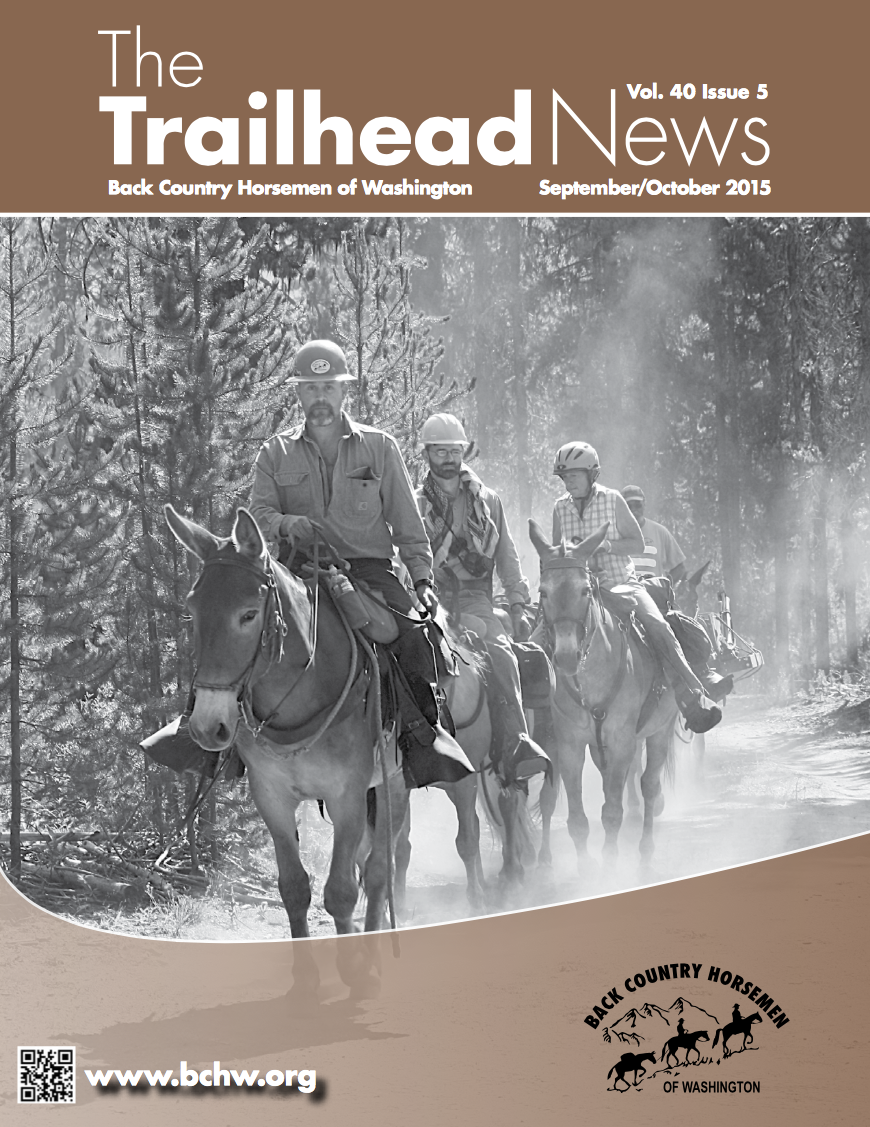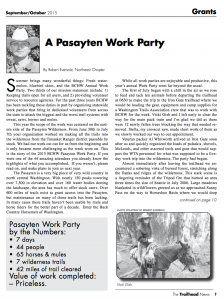 As Published in the Trailhead News
As Published in the Trailhead News
September / October 2015 issue
Summer brings many wonderful things. Fresh watermelon, bluebird skies, and the BCHW Annual Work Party. Two thirds of our mission statement include: 1) Keeping trails open for all users, and 2) providing volunteer service to resource agencies. For the past three years BCHW has been tackling these duties in part by organizing statewide work parties that bring in dedicated volunteers from across the state to attack the biggest and the worst trail systems with sweat, saws, horses and mules.
This year the scope of the work was centered on the eastern side of the Pasayten Wilderness. From June 30th to July 7th your organization worked on making all the trails into the wilderness from the Tonasket Ranger district passable by stock. We had our work cut out for us from the beginning and it only became more challenging as the week wore on. This is the story of the 2015 BCHW Pasayten Work Party. If you were one of the 44 amazing attendees you already know the highlights of what you accomplished. If you weren’t, please read on, and make plans to join us next year.
The Pasayten is a very big piece of very wild country in north central Washington. With nearly 150 peaks towering over 7,500 in elevation and over 160 water bodies dotting the landscape the area has much to offer stock users. Over 600 miles of trails exist to grant access into the Pasayten, but maintenance on many of those trails has been lacking. In many cases these trails haven’t been usable by mule and horse riders for the better part of a decade. Enter the Back Country Horsemen of Washington.
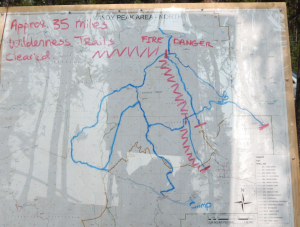 Pasayten Work Party by the Numbers:
Pasayten Work Party by the Numbers:
7 days
44 people
65 horses & mules
7 wilderness trails totaling 42 miles of trail cleared
Value of work completed – Priceless
While all work parties are enjoyable and productive, this year’s Annual Work Party went far beyond the usual.
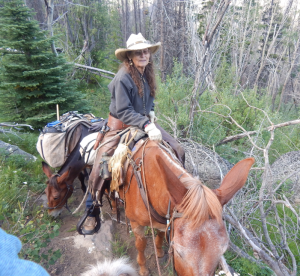
Vicki G and her trusty mule
The first of July began with a chill in the air as we rose to feed and tack 10 animals before departing the trailhead at 0630 to make the trip to the Iron Gate trailhead where we would be loading the gear, equipment and camp supplies for a Washington Trails Association crew that was to work with BCHW for the week. Vicki Gish and I left early to clear the way for the main pack train and I’m glad we did as there were 12 newly fallen trees blocking the way that needed removed. Stella, my crosscut saw, made short work of them as we slowly worked our way to our appointment.
Veteran packer Al Whitworth arrived at Iron Gate soon after us and quickly organized the loads of pulaskis, shovels, McLeods, and other assorted tools and gear that would support the WTA personnel for what was supposed to be a five-day work trip into the wilderness. The party had begun.
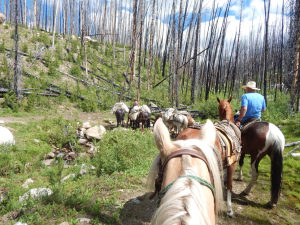
Riding through an old burn
Almost immediately after leaving the trailhead we encountered a sobering vista of burned forest, stretching along the flanks and ridges of the wilderness. This stark scene is a lingering reminder of the Tripod fire that burned an area three times the size of Seattle in July 2006. Large meadows blanketed in wildflowers greeted us as we approached Sunny Pass on the way to Horseshoe Basin where we would drop off our load. A snug camp in the wilderness would be our home for the night before returning the following morning to our next assignment. Little did we know that almost 9 years to the day after the start of the Tripod incident another wildfire would occur in the same area.
The nearby peaks shown like gold in the early morning sun the morning of the 2nd as we broke camp, said our good byes to the trail crew and made our way back over Sunny Pass. After 16 miles and 6 hours we arrived at the BCHW main camp with horses, mules, and humans alike tired after a long haul. Once the beasts were watered, fed, brushed, and tended to it was time to take a moment for us. As I settled into a cozy camp chair I noticed a cloud rising above the forest. Thick, swirling, and the color of an old bruise, this was no sunny day wisp. A forest fire was burning in the wilderness, near the spot from which we had just returned.
As we watched the smoke plume slowly twist upward, the Forest Service soon decided that the WTA trail crews would evacuate their camp immediately, leaving behind all of the their tools and gear. The BCHW base camp was located upwind from the fire and out of immediate danger so we were safe at least for the time being. If it were safe to do so the following day a BCHW pack crew would make its way to the WTA campsite and retrieve the gear we had just delivered. If it still existed. The rest of the day was spent with a close eye on the direction of the smoke plume.
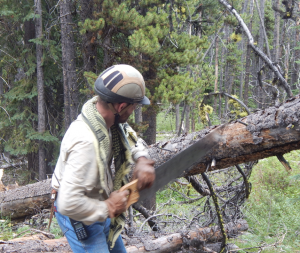
The Author and Stella at work
Friday, the 3rd, brought good news. The fire had spread only slightly during the night. It was safe for the packers to head in and collect the trail crew’s equipment and OK for the rest of the BCHW group to continue clearing trails and replacing lost trail signs west of the area impacted by the fire. Vicki and I reported in to Kathy Young’s sign crew and proceeded up the trail to Windy Peak. Although the path to Windy Peak was some nine miles away from Horseshoe Basin traveling through the forest of fire-killed trees was a constant reminder to stay alert to the radio and to the smoke plume overhead. Shortly after midday the Siebel clan, of Dave and Becky, joined us as we made our way back to camp stopping to unleash Stella on the many fallen logs that blocked our way.
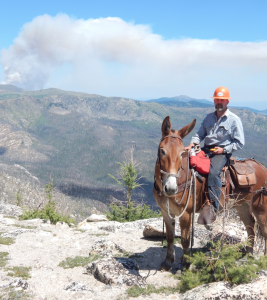
Jason R with Bill, observing the Newby Lake FIre
Independence Day found me joining the organizer and leader of the work party Jason Ridlon, Darrel Gunnells, Cathy Nelson, and Kathy Young. The plan was to install trail signage past the crest of Windy Peak and then to work our way down the mountainside, clearing trail as we went. The long climb to the top of Windy took longer than expected and we had to turn around after placing our trailer marker. However from the top of the peak the smoke plume from the wildfire was both fascinating and scary as the fire raged only a few short miles away.
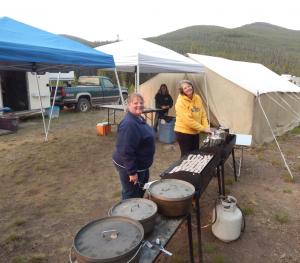
The most important part of the operation – the Camp Cooks
The daily routine of the work party continued in a similar manner throughout the trip. Rise early to feed and water the animals. Grab a quick breakfast and lunch from the tireless and remarkable camp cooks, led by Kim Merrick, then ride out to clear and maintain trails. Return to base camp in the evening and repeat the process the following morning. While the sounds of a well sharpened crosscut singing its way through a fallen tree and the scraping of a Pulaski clearing a waterbar are soothing, there’s no denying that this was/is hard work.
A light coating of ash on the morning of the 7th marked the last day of the shindig. The fire was still burning, but thankfully away from the main body of trails that we had re-claimed from the forest. Over 42 miles in total of wilderness trails are once again passable by stock users and hikers that will appreciate not having to crawl, climb, and scramble through deadfall.


